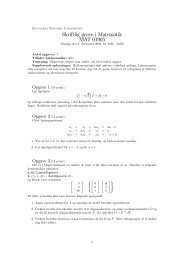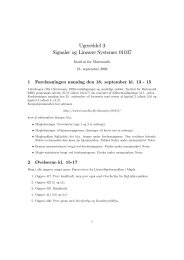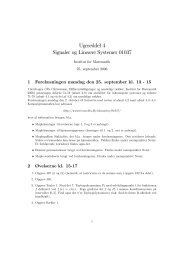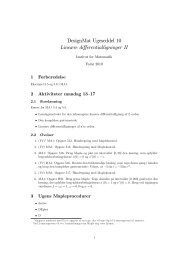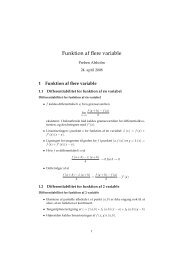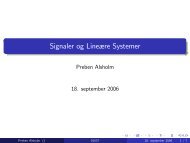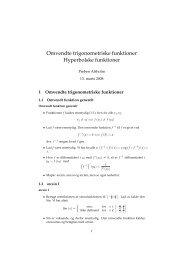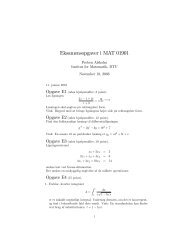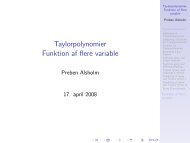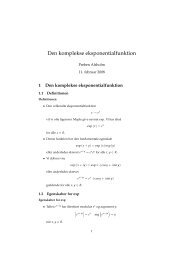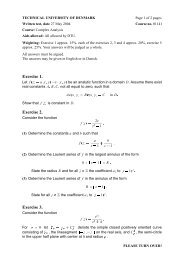Complex Numbers
Complex Numbers
Complex Numbers
You also want an ePaper? Increase the reach of your titles
YUMPU automatically turns print PDFs into web optimized ePapers that Google loves.
<strong>Complex</strong> <strong>Numbers</strong>Preben AlsholmSeptember 4, 20081 <strong>Complex</strong> <strong>Numbers</strong>1.1 Sets of numbersSets of numbers N is the set of natural numbers, 1, 2, 3, 4, 5, . . . Z is the set of integers . . . 5, 4, 3, 2, 1, 0, 1, 2, 3, 4, 5, . . .. Q is the set of rational numbers, i.e. fractions and integers. R is the set of real numbers. Can be identified with the set of points ona straight line, the real number line. Irrational numbers are real numbersthat are not rational. C is the set of complex numbers. Can be identified with the set of pointsin the plane, the complex plane. <strong>Complex</strong> numbers that are not real arecalled imaginary. We have N Z Q R C.1.2 Rules for addition and multiplicationRules for addition and multiplication1. a + b = b + a (the commutative law of addition)2. (a + b) + c = a + (b + c) (the associative law of addition)3. ab = ba (the commutative law of multiplication)4. (ab) c = a (bc) (the associative law of multiplication)5. a (b + c) = ab + ac (the distributive law)6. a + 0 = a7. 1a = a8. a + x = 0 has precisely one solution for x9. ax = 1 has precisely one solution for x, provided a 6= 010. Every Cauchy sequence has a limit1
1.3 What is a Cauchy sequence?What is a Cauchy sequence? A Cauchy sequence is a sequence of numbers (x n ) ∞ n=1 = x 1, x 2 , x 3 , . . . , x n , . . .satisfying x n x m ! 0 for n, m ! ∞. That every Cauchy sequence has a limit means that x n x m ! 0 forn, m ! ∞ implies that there exists a number x, such that x n ! x forn ! ∞. The claim: Every Cauchy sequence has a limit is valid for R and C, not forQ. C has the very important property that every polynomial of degree 1 hasat least one root. (The Fundamental Theorem of Algebra).2 Description of the complex numbersDescription of the complex numbers As a set C equals the set of points in the plane. The plane is identifiedwith R 2 , thus C = R 2 . The point (a 1 , a 2 ) is written a 1 + a 2 i. Thus i is the point (0, 1) and 1 is thepoint (1, 0). Definition of addition. If a = a 1 + a 2 i and b = b 1 + b 2 i then a + b =(a 1 + b 1 ) + (a 2 + b 2 ) i. Definition of multiplication. If a = a 1 + a 2 i and b = b 1 + b 2 i thenab = (a 1 + a 2 i) (b 1 + b 2 i) = (a 1 b 1a 2 b 2 ) + (a 1 b 2 + a 2 b 1 ) i It follows that i 2 = 1.2.1 Division?Division? The solution to the equation az = 1 exists if a 6= 0 and is uniquely determined.It is denoted a 1 or 1 a . By b a we mean ba 1 . It is the solution to the equation az = b The usual method of calculating b a :2 + 3i4 + 7i==(2 + 3i) ( 4 7i) (2 + 3i) ( 4 7i)=( 4 + 7i) ( 4 7i) ( 4) 2 (7i) 2(2 + 3i) ( 4 7i)16 + 49=13 26i65= 1 525 i2
2.2 Real and imaginary parts etc.Real and imaginary parts etc. Real part: Re (a 1 + ia 2 ) = a 1 . Imaginary part: Im (a 1 + ia 2 ) = a 2 <strong>Complex</strong> conjugate: a = a 1 + ia 2 = a 1 ia 2 a + b = a + b and (ab) = ab Modulus, absolute value: jaj = ja 1 + ia 2 j = jabj = jaj jbj The triangle inequality: ja + bj jaj + jbj2.3 Polar form IPolar form Iqa 2 1 + a2 2 Let r = jaj and v be an angle measured from the positive real axis tothe line connecting 0 and a (measured positive in the counterclockwisedirection). v is an argument for a. Notation: arg (a). The set of arguments for a isfv + p2π jp 2 Z g. Any complex number can be written in polar form: a = r (cos v + i sin v),where r is the modulus and v is an argument of a.2.4 Polar form IIPolar form II The principal value: Arg (a) is the uniquely given argument in the interval] π, π]. By arg τ(a) we mean the unique argument in the interval ]τ, τ + 2π], thusArg (a) = arg π(a). arg (ab) = arg a + arg b3
arg (a n ) = n arg a arg a b = arg a arg b These must be properly understood: Thus arg (ab) = arg a + arg b meansthat one of the arguments for ab is obtained by adding an argument for aand an argument for b.2.5 The <strong>Complex</strong> ExponentialThe <strong>Complex</strong> Exponential The real exponential function exp has the fundamental propertyi.e. e x+y = e x e y for all x, y 2 R.exp (x + y) = exp (x) exp (y) Definition. If z = x + iy (x, y 2 R) thenexp (z) = exp x (cos y + i sin y) ex+iy = e x and arg e x+iy = y when x, y 2 R. exp (z 1 + z 2 ) = exp z 1 exp z 2 for all z 1 , z 2 2 C, i.e. e z 1+z 2 = e z 1e z 2. Proof: Let z 1 = x 1 + iy 1 and z 2 = x 2 + iy 2 , thene x 1+iy 1 e x 2 +iy 2 = ex 1 e x 2je z 1 e z 2j = je z 1j je z 2j == e x 1+x 2= e x 1+x 2 +i(y 1 +y 2 ) = e z 1 +z 2 arg (e z 1 e z 2) =arg (e z 1) + arg (e z 2) = arge x 1+iy 1= y 1 + y 2 = arge x 1+x 2 +i(y 1 +y 2 )= arg e z 1+z 2+ arge x 2+iy 22.6 The polar form once moreThe polar form once more The polar form for the number a having modulus r and argument v waswrittena = r (cos v + i sin v)In the future we shall write:a = r exp (iv) = re ivrp p 2 Example. The polar form for 3 i. Modulus: 3 + ( 1) 2 =5π2. An argument is 6. Thusp3 i = 2 exp i 5π = 2e i 5π 664
2.7 De Moivre’s formulaDe Moivre’s formula For n 2 N og θ 2 R gælder(cos θ + i sin θ) n = cos nθ + i sin nθ Proof: (cos θ + i sin θ) n =e iθ n= e inθ = cos nθ + i sin nθ Example.cos 3x = Re (cos 3x + i sin 3x) = Re(cos x + i sin x) 3= Re cos 3 x + 3i cos 2 x sin x 3 cos x sin 2 x i sin 3 x = cos 3 x 3 cos x sin 2 x = cos 3 x 3 cos x 1 cos 2 x= 4 cos 3 x 3 cos x By replacing Re with Im above we get the formulasin 3x = 3 cos 2 x sin x sin 3 x = 3 1 sin 2 x sin xsin 3 x= 4 sin 3 x + 3 sin x5



